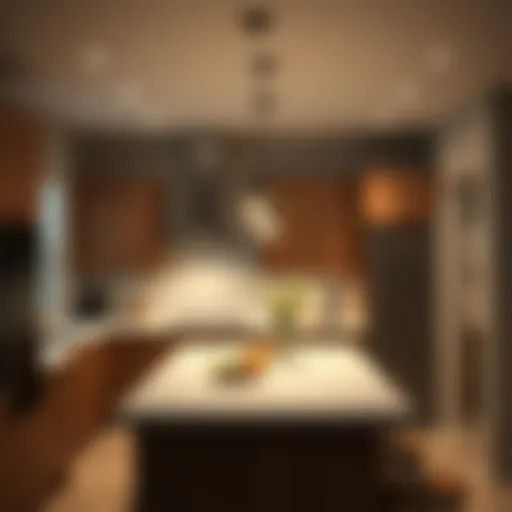Replacement Bathroom Cabinet Doors and Drawer Fronts Guide
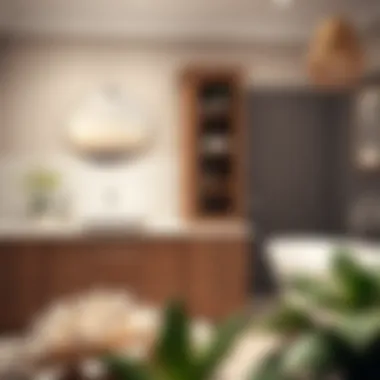

Intro
Replacing bathroom cabinet doors and drawer fronts can breathe new life into an outdated space, often making a world of difference with just a few thoughtful touches. This guide aims to provide homeowners and DIY enthusiasts with substantial insights into the various aspects of this renovation task. There's universal appeal in the bathroom, serving as a sanctuary for many, or at the very least, a frequently visited area of the house. Thus, understanding the style, materials, care tips, and installation techniques not only elevates aesthetics but also enhances the functional aspects of your bathware. We will navigate the latest trends, practical advice, and useful strategies to ensure a seamless transformation.
Furniture Styles and Trends
Modern vs. Traditional: Understanding the Aesthetics
When it comes to choosing replacement cabinet doors and drawer fronts, styles can make or break your bathroom’s vibe. The divide between modern and traditional aesthetics is striking and each has its own unique charm.
- Modern Styles often include clean lines and minimalist designs. Think sleek, flat-panel doors in glossy finishes that reflect light and add a feeling of spaciousness. This is perfect for those who value a contemporary look but still want plenty of functionality.
- Traditional Styles, on the other hand, lean towards ornate details and rich wood grains. Raised panels and intricate molding speak of classic craftsmanship, attracting those who appreciate timeless elegance.
Understanding where your style preference lies is paramount as it dictates the selection of materials and the overall feel of the bathroom.
Color and Material Trends: What's In and What's Out
Colors and materials speak volumes about trends. The palette has shifted in recent years, with homeowners increasingly shying away from bland whites and beiges to vibrant, expressive shades.
- Current Trends:
- Deep blues, greens, and even earthy browns are gaining popularity, reflecting nature and providing a calming encounter.
- Natural materials like oak, reclaimed wood, or bamboo are favored for their sustainable qualities and organic appeal.
"Choosing the right color isn’t just about looks; it’s about feeling. The right hue can turn a functional space into an escape."
Conversely, some trends are fading. Bright plastic laminates have mostly been replaced by sophisticated materials that offer a touch of luxury and durability. Homeowners should do their due diligence to understand the long-term implications of their choices.
Furniture Care and Maintenance
Tips for Prolonging the Life of Your Furniture
After your replacement project, maintaining your new bathroom cabinet doors and drawer fronts is crucial for longevity.
- Keep surfaces clean using a damp cloth infused with mild soap, steering clear of harsh chemicals.
- Avoid excessive humidity or moisture, which can warp the material over time.
- Regularly check for loose hardware and tighten as needed. By investing a little time periodically, you can prevent future repairs and replacements.
DIY Repair Hacks for Common Furniture Issues
It's always a better route to tackle minor issues yourself, preserving the look and functionality of your cabinets.
- Scratches: A dab of matching paint or wood stain can disguise many blemishes effectively. You can also use a bit of crayon to fill in deep scratches, then buff it smooth.
- Doors that don't close properly: Adjust the hinges by loosening the screws slightly, repositioning, and tightening them back up.
In many cases, simple fixes can save the day and prolong the life of your investment.
For additional insights on trends, techniques, and DIY guidelines, you might refer to resources such as Wikipedia for basic overviews, and platforms like Reddit for community discussions around home designer hacks.
Understanding Bathroom Cabinetry
Bathroom cabinetry plays a pivotal role in both functionality and aesthetics within the space. When you think about it, cabinets are not just boxes to store your essentials; they are integral to the overall design and feel of a bathroom. Understanding the nuances of bathroom cabinetry provides homeowners, designers, and DIY enthusiasts with the knowledge to create a space that resonates with personal style while being practical.
Overview of Bathroom Cabinets
Bathroom cabinets come in various styles, sizes, and configurations, each serving unique purposes. Whether it’s a modest vanity unit or an expansive built-in shelf, the right cabinetry can enhance the efficiency of your bathroom. Common materials include solid woods, laminate, and MDF, each having its pros and cons based on cost, durability, and appearance. It’s essential to keep in mind factors such as moisture resistance, especially in environments like bathrooms where humidity can be a major player.
- Types of Cabinets: Wall-mounted, free-standing, and corner units are some popular types.
- Storage Solutions: Consider options like drawers, shelves, and cupboards to maximize your space.
By understanding the varieties available, one can strategically choose cabinetry that complements the layout of the room, ultimately impacting both the organization and the visual aesthetic.
Significance of Cabinetry in Bathroom Design
The cabinetry’s influence on bathroom design is crucial—it’s often the first thing a visitor notices. Well-designed cabinets not only provide functionality but also tie together the room’s style. A contemporary bathroom might benefit from sleek, minimalistic cabinets, while a traditional space could shine with ornate wooden designs. The choices you make can dictate the ambiance:
"Cabinets can enhance or detract from a room’s overall design. Choosing wisely can truly transform a space."
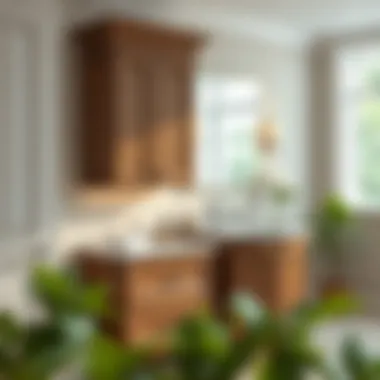

- Visual Appeal: Cabinets serve as a focal point and can set the tone for the decor.
- Utility: Organizing toiletries, linens, and cleaning supplies keeps clutter at bay, which is essential for a serene bathroom experience.
- Value Additions: Investing in high-quality cabinetry can potentially boost the property’s value, making it attractive to future buyers.
When considering bathroom renovations or upgrades, focusing on cabinetry is essential. With the right selection of cabinet doors and drawer fronts, you can elevate your bathroom’s design while ensuring it remains functional and inviting.
Reasons to Replace Cabinet Doors and Drawer Fronts
Replacing bathroom cabinet doors and drawer fronts is not merely a cosmetic choice; it has far-reaching effects on both the usability and aesthetics of your bathroom. Homeowners often overlook cabinetry, but in reality, it's a critical component in the overall design scheme and functionality of the space. Here, we will explore why upgrading these features is not only beneficial but often necessary.
Aesthetic Upgrades
When it comes to bathroom renovation, many people have a tendency to focus on tiles, flooring, or fancy fixtures. The truth is, the look of your cabinets has a significant impact on how the space feels. A cabinet’s appearance can either brighten a room or drag it down like a lead anchor. For instance, a dull, worn-out cabinet door might be the last thing on your mind, but once it’s replaced with a fresh, modern panel, you might be surprised how much of a difference it makes. Consider opting for shaker-style doors for a clean, contemporary look, or moving towards more elaborate designs if you desire a traditional vibe.
The variety in styles, finishes, and colors means that there is something to fit every personal preference. By replacing these fronts, you can effortlessly elevate your space without undertaking a complete renovation, which brings us to the heart of the matter: it’s all about maximizing utility while minimizing hassle.
"A makeover doesn’t always have to be an overhaul, sometimes it’s just a tweak here and there that can usher in a new era of style!"
Imagine walking into a bathroom that feels dated and cramped, yet with minimal effort, you could create a refreshing, open-feeling area. For example, pale shades in cabinetry can make a room feel more expansive, while darker tones can add depth and drama.
Functional Improvements
Beyond aesthetics, the functionality of your bathroom can greatly benefit from new cabinet doors and fronts. Old cabinet fronts might sag, align improperly, or even be painted with harmful materials leading to performance issues. By upgrading, you can enhance both ease of use and storage capabilities.
New doors can feature soft-close hinges, providing a quieter closing action which not only enhances satisfaction in daily use but also minimizes wear and tear on the cabinets. Think of the countless times you've slammed a drawer shut in frustration; soft-close mechanisms can eliminate that irritation.
Moreover, a replacement is a great opportunity to reevaluate organization. Adding dividers or pull-out trays during this upgrade can make a world of difference in how items are stored. Suddenly, everything from toiletries to towels has a place and is easily accessible, saving time in your morning routine.
In sum, upgrading cabinet doors and drawer fronts offers both aesthetic pleasure and practical advantages. It’s a win-win situation where form meets function. By investing a bit of time and resources into these elements, you’ll not only refresh your bathroom but also improve the experience it offers on a daily basis.
Selecting the Right Materials
Choosing the right materials for bathroom cabinet doors and drawer fronts is no small feat. This decision plays a pivotal role in the overall aesthetic and functionality of your bathroom space. The materials you select can drastically influence durability, maintenance, and of course, the look of the cabinets. It's worth spending a bit of time evaluating your options so you can align your choices with both your style and practical needs.
Understanding the characteristics of various materials helps in making informed selections. For instance, some materials can withstand the moisture typically found in bathrooms better than others. Additionally, considerations like cost, ease of installation, and how they will hold up over time can guide your decision-making process.
Ultimately, this section aims to equip homeowners, designers, and DIY enthusiasts with the knowledge to choose materials that not only look good but also stand the test of time.
Wood vs. Laminate
When it comes to cabinet doors, wood and laminate stand out as two popular contenders. Each has its own set of advantages, and the decision often comes down to what works best in your space.
Wood options, like oak or maple, offer a classic charm and can be sanded down and refinished as needed, extending their lifespan. They have a natural warmth that laminate simply can't replicate.
On the flip side, laminate is often more cost-effective and available in a vast array of colors and finishes. It’s generally easier to clean and resistant to scratches, making it a solid choice for families. However, once damaged, laminate can’t typically be repaired in the same way wood can.
"Choosing between wood and laminate really boils down to durability versus aesthetics; the former may require more maintenance but offers timeless appeal."
Melamine Options
Melamine is often overlooked but has been gaining popularity for cabinet doors and drawer fronts, especially among cost-conscious homeowners. Made from a particleboard core covered in a plastic finish, melamine is durable and easy to clean.
Many people favor melamine for its versatility in design. It’s offered in various colors and can mimic more expensive materials without the high price tag. However, it’s important to note that melamine can sometimes chip more easily compared to solid wood. While not a long-term solution for everyone, melamine can be perfect for those looking to achieve a fresh look without breaking the bank.
Glass Fronts for a Modern Touch
Incorporating glass fronts into bathroom cabinetry can create a striking focal point. This material is often used in more contemporary designs, providing an elegant, open feel.
Glass is not only available in clear but also frosted or textured options, allowing you to define how much visibility you want. While they can add a touch of luxury, it’s crucial to consider the maintenance needed; glass shows fingerprints and smudges easily, which may not be ideal in a high-traffic bathroom.
Overall, glass can elevate the design of your cabinetry, making it a standout feature in your bathroom.
In Summary
In selecting the right materials for your bathroom cabinet doors and drawer fronts, consider the balance between aesthetic appeal and practical needs. Weigh the benefits of wood’s warmth against laminate’s durability, explore the affordability of melamine, and don't shy away from the elegance that glass fronts can bring. Each material has its place, and understanding these nuances can help you make the best choice for your needs.
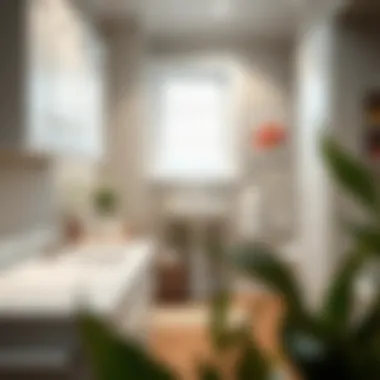

Design Considerations for Cabinet Doors and Drawer Fronts
When diving into the world of bathroom cabinet doors and drawer fronts, design considerations hold significant weight. The right choice can mean the difference between a space that feels chaotic or one that exudes harmony. It’s not just about slapping on a new surface; it’s about finding a balance between aesthetics and practicality that aligns with your vision and the overall atmosphere of your bathroom.
Style Compatibility
Style compatibility plays an essential role in ensuring that your new cabinetry integrates seamlessly into the existing decor. When choosing cabinet doors and drawer fronts, it's crucial to consider the architectural style of your bathroom.
- Traditional vs. Modern: For example, if your bathroom leans towards a classic, traditional style, opting for ornate, raised panel doors might resonate perfectly. In contrast, a sleek, flat panel door aligns better with a more contemporary look.
- Cohesion: Ensuring that new cabinet designs complement other elements like light fixtures, flooring, and even the sink can help create a cohesive aesthetic. It might help to browse through design magazines or platforms such as Pinterest for inspiration tailored to your specific style.
Color Schemes and Finishes
The color schemes and finishes you choose can dramatically influence the atmosphere of your bathroom. Light colors tend to make spaces feel larger and airier, while darker hues can lend coziness and depth.
- Current Trends: Soft pastels and muted tones are quite popular now, reflecting a shift towards more serene spaces. However, bolder choices like deep navy or forest green can become statement pieces that demand attention.
- Finish Types: Don’t forget about finishes. A matte finish might suit a modern aesthetic, while a glossy finish can brighten the space and give it a polished look. Consider how the light in your bathroom interacts with your chosen colors and finishes—this can impact how the elements come together.
"Choosing the right color and finish is like creating a canvas for your entire bathroom; every choice sets a mood."
Door Types: Shaker, Flat, and Raised Panel
When it comes to door types, understanding the distinctions between shaker, flat, and raised panel designs can help make an informed decision.
- Shaker Doors: Known for their simple, and functional style, shaker doors provide clean lines and a classic look that works with many design schemes. They are easily customizable, making them ideal for someone who wishes to add personal flair.
- Flat Doors: If you're aiming for a modern and minimalist vibe, flat doors may be your best bet. They usually come without any embellishments, creating a sleek look that pairs well with vibrant colors or textures that can serve as a backdrop.
- Raised Panel Doors: Often seen in traditional settings, raised panel doors add dimension and detail. They can elevate the overall ambiance of your bathroom, offering an opportunity to add intricate designs or unique hardware that can serve as focal points.
Measuring for Replacement
Measuring accurately is the cornerstone of any cabinetry project. If the measurements aren't on point, even the most beautifully crafted doors and drawer fronts can end up being a tight squeeze or simply won't fit. It's akin to trying to shove a square peg in a round hole—frustrating and entirely unnecessary. Understanding how to measure for replacement cabinetry not only saves you time but also avoids the heartache of costly mistakes.
When it comes to bathroom cabinetry specifically, this precision is even more critical. Bathrooms can often be compact spaces, where every millimeter counts. A well-fitting door or drawer front can enhance functionality while also uplifting the room's aesthetic appeal. Let's unravel the specifics of how to get those measurements right, ensuring your replacement doors and drawer fronts fit as snug as a bug in a rug.
Accurate Measurements for a Perfect Fit
Getting the perfect measurements doesn’t have to feel like rocket science. It's straightforward if approached methodically. Here’s what you need to consider:
- Measure the Cabinet Opening: First and foremost, measure the width and height of the cabinet opening where the door will be installed. Take this measurement in several places—at the top, middle, and bottom—just in case the cabinet is not perfectly even.
- Depth Matters: For drawer fronts, it’s not just about height and width. Measuring the depth is equally important to ensure that the new fronts align with the existing drawer boxes.
- Consider the Overlay: Overlay is the amount by which the door or drawer front extends beyond the cabinet frame. Knowing whether you’re opting for a full overlay, partial overlay, or inset style will influence your measurements.
- Account for Distances: Consider the distance from the floor, the adjacent walls, and any fixtures, such as sinks or light switches. These factors can affect how much space you have available.
Upon finishing the measurement process, double-checking each figure is crucial. Write down your measurements, and if possible, sketch a quick diagram to visualize your space.
Tools Required for Measurement
To get those measurements right, several tools can come in handy:
- Tape Measure: A long tape measure is essential. This allows for easy measurement of both width and height.
- Level: A level will tell you if a cabinet is even, which is key for accurate heights.
- Square: A carpenters square can help ensure that your measurements are straight, particularly when dealing with corners.
- Pencil and Paper: For jotting down measurements and making notes about the style and type of doors or fronts you are considering.
Understanding how to measure accurately not only facilitates a smooth replacement process but also contributes to a more polished finished product. Rushing through measurements can lead to a cascade of issues that affect the overall look of your bathroom. As the saying goes, measure twice, cut once! It’s a mantra that saves you time, money, and an awful lot of hassle.
Installation Process
The installation process for replacing bathroom cabinet doors and drawer fronts is a pivotal aspect of any home improvement project. It's not just about swapping out old doors for new ones but creating an elegant and well-functioning area in your bathroom. This stage can greatly impact the overall design and practicality of the space. A precise installation delivers a polished look and ensures that everything operates smoothly, enhancing the usability of your cabinetry. Plus, this can add value to your home, appealing to potential buyers if you ever decide to sell.
Preparation Steps
Before diving into the installation, thoughtful preparation can save you significant hassle down the road. Here are the main steps you should take:
- Clear Space: Remove all items from your cabinets and drawers. This step helps you visualize and access all areas you’ll be working on.
- Take Inventory: Ensure you have all the materials ready—this includes your new cabinet doors, drawer fronts, hinges, and knobs. It’s wise to double-check against your list to avoid last-minute trips to the store.
- Check Existing Hardware: Examine existing hinges and handles. If they are worn or mismatched, consider replacing them to achieve a cohesive look.
- Gather Tools: Getting your tools in order beforehand will streamline the process. Make sure to have a drill, screwdriver, level, measuring tape, and possibly a stud finder on hand.
Step-by-step Installation Guide
With the preparations complete, it is time to tackle the installation. Follow these steps for a systematic approach:
- Remove Old Doors and Drawer Fronts: Start by detaching the old cabinet doors using a screwdriver. Unscrew the hinges and gently lift the doors off. For drawer fronts, unscrew them from the sides, and pull them off carefully.
- Measure the New Doors: Before installing the new ones, measure their position. Place the new doors where they should hang and use a level to ensure they are perfectly aligned.
- Attach New Hinges: Take one door at a time, attach new hinges as per the manufacturer’s instructions. Ensure they are aligned for proper operation.
- Install Drawer Fronts: Position your new drawer fronts on the drawers and secure them. It’s essential that they sit flush against each other, offering a seamless appearance.
- Check Alignment and Functionality: After everything is installed, open and close doors and drawers several times to ensure they operate without hindrance.
Tools and Supplies Needed
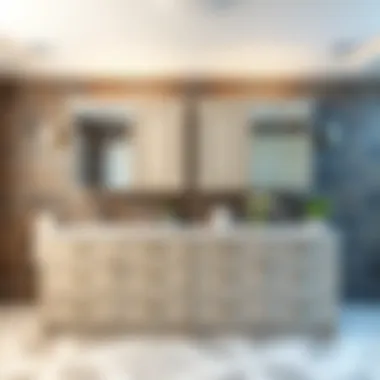

When prepping for the installation, be equipped with the following essentials:
- Drill: For efficient screw insertion.
- Screwdriver: A trusty tool for loosening and fastening screws.
- Level: This is critical for ensuring everything is aligned properly.
- Measuring Tape: Accurate measurements prevent costly mistakes.
- Stud Finder: Helpful for screwing into secure points for heavier doors.
- Replacement Parts: Make sure to have extra screws, hinges, and potentially handles.
Proper installation is just as important as selecting the appropriate materials. A well-installed cabinet can elevate the functionality and overall design of your bathroom.
Maintenance and Care for Cabinetry
Taking care of your bathroom cabinetry is akin to nurturing a garden; with the right maintenance, it can flourish beautifully, adding charm and functionality to your space. Cabinet doors and drawer fronts endure daily use and exposure to moisture, making regular care essential. Maintaining your cabinetry not only extends its lifespan but also keeps your bathroom looking fresh and inviting. This section will delve into the critical aspects of maintenance, focusing on cleaning techniques tailored for various materials and preventive measures to enhance durability.
Cleaning Techniques for Different Materials
When it comes to cleaning, understanding the specific needs of your cabinetry's material is vital. Here are some common materials and effective cleaning strategies:
- Wood: Wooden cabinet doors can develop scratches and lose their sheen over time. To clean, wash them gently with a damp cloth using a mild soap solution. Avoid excess water to prevent warping. After cleaning, polish with furniture wax or a dedicated wood conditioner to nourish and protect the finish.
- Laminate: These surfaces are generally more forgiving. Use a mixture of vinegar and warm water to wipe down laminate doors. This can help lift grime without damaging the finish.
- Melamine: For melamine surfaces, a soft sponge with a non-abrasive cleaner works wonders. Harsh chemicals can erode the surface, so choose gentler options to keep the finish intact.
- Glass Fronts: Glass cabinets can become streaky if not cleaned properly. A solution of equal parts vinegar and water is effective here. Use a microfiber cloth for a streak-free shine.
Remember: Testing any cleaner in a small, inconspicuous area before applying it on the entire surface is a wise move to avoid unwanted surprises.
Preventive Measures to Extend Longevity
Caring for your cabinetry extends beyond routine cleaning. Adopting preventive measures is key to enhancing durability:
- Control Humidity: Bathroom environments can get steamy, leading to moisture damage. Use exhaust fans or open windows during showers to keep humidity levels in check. This simple action can save your cabinetry from warping or peeling over time.
- Avoid Direct Heat: Ensure that heaters or hot appliances are not placed too close to wooden or laminate cabinets. The warping caused by high temperatures can lead to irreversible damage.
- Regular Inspections: Make it a habit to regularly check for signs of wear and tear, including loose hinges or peeling edges. Quick fixes can prevent further deterioration and enhance the overall lifespan of your cabinetry.
- Use Soft Closing Mechanisms: If possible, installing soft close hinges can greatly reduce the noise and impact caused when cabinet doors are shut, minimizing wear on the cabinetry over time.
Your bathroom cabinets—like any good relationship—thrive with tender loving care. Whether it's simple cleaning or implementing savvy preventive strategies, your investment will pay off handsomely in aesthetics and performance for years to come.
Emerging Trends in Bathroom Cabinetry
The world of bathroom cabinetry is ever-evolving, with trends emerging that reflect changes in lifestyle, environmental awareness, and technology. These shifts are not just whims; they speak to a deeper understanding of how we utilize space in our homes. As homeowners, designers, and DIY enthusiasts navigate the maze of options available today, knowing the emerging trends in bathroom cabinetry plays a pivotal role in making informed decisions. Such decisions not only affect aesthetics but also impact functionality and sustainability in significant ways.
Sustainable Materials and Practices
Sustainability has become more than just a buzzword; it’s a vital consideration for many homeowners looking to update their spaces. Using sustainable materials in bathroom cabinetry isn’t just good for the environment; it can also enhance the overall design and feel of the space. For instance, cabinetry made from reclaimed wood or bamboo not only reduces the demand on new resources but also brings in unique textures and stories from the materials themselves.
Additionally, environmentally friendly finishes that utilize low volatile organic compounds (VOCs) are becoming increasingly popular. These finishes are safer for indoor air quality, especially in smaller spaces like bathrooms where ventilation may be limited. Homeowners opting for sustainable practices are bringing a conscious approach to remodeling, ensuring their improved spaces reflect their values.
“Going green doesn’t just make sense; it feels good too!”
Smart Storage Solutions
As bathrooms often find themselves on the smaller side, effective storage solutions remain a hot topic in cabinetry design. Recent trends showcase cabinets with built-in organizers, pull-out shelves, and concealed compartments that help maximize space without sacrificing style. Homeowners are getting more creative with their use of vertical spaces by incorporating tall cabinets that reach the ceiling, allowing them to take full advantage of every inch available.
Smart storage doesn’t end with mere organization; it’s intertwined with convenience. The rise of modular cabinetry systems allows homeowners to customize layouts according to personal needs. Each piece can be tailored, making it easier to adapt to lifestyle changes over time. This flexibility not only enhances usability but also lends a modern edge to bathroom design.
Integration of Technology
Technology integration has rapidly transformed how we approach bathroom installations. Innovations like touch-activated cabinets and built-in LED lighting create not just functionality but an experience. Homeowners can look forward to smart mirrors with integrated Bluetooth sound systems and touch controls that influence how their bathroom feels and operates.
Moreover, technology isn’t just about luxury—the incorporation of energy-efficient lighting and water-saving fixtures aligns with the trend of sustainability. These advancements speak to a generation that values efficiencies both in costs and environmental impacts. Automation for lighting and temperature control is also becoming increasingly common, allowing for customizable experiences tailored to the user’s preferences.
In sum, the emerging trends in bathroom cabinetry signify a shift towards smarter, more sustainable, and user-centric design. As we embrace these changes, it’s essential to consider how our choices resonate beyond aesthetics, impacting daily life and the planet. Keeping abreast of these trends can steer successful renovations that reflect who we are today and who we want to be tomorrow.
Ending
In wrapping up this insightful exploration of replacing bathroom cabinet doors and drawer fronts, it’s vital to emphasize the significant impact such renovations can have on your bathroom's overall feel and function. This isn’t merely about aesthetics; it's about creating a space that resonates with personal style while enhancing usability.
Recap of Key Points
Delving into our discussion, we covered a range of critical points:
- Understanding Cabinetry: A bathroom cabinet’s role extends beyond storage. It’s an integral part of the design landscape, affecting the entire atmosphere.
- Reasons for Replacement: Homeowners often embark on this journey to breathe new life into an outdated design or to improve functionality. A fresh look can significantly elevate the space without the need for a complete remodel.
- Material Selection: Whether opting for classic wood, modern laminate, or sleek glass, knowing the advantages and disadvantages of each material helps to make an informed choice.
- Design Elements: Compatibility in style, color schemes, and types of doors can take a bathroom from drab to fab—they're the finishing touches that pull everything together.
- The Installation Process: A step-by-step guide clarified the practical aspects of actually replacing those doors and drawer fronts, emphasizing the tools and preparation needed.
- Maintenance Tips: Lastly, understanding how to care for your cabinet doors ensures longevity and sustained aesthetic appeal.
Encouragement for DIY Projects
This article aims primarily at homeowners and DIY enthusiasts. The good news? Taking on a project involving cabinet doors and drawer fronts can be extremely rewarding. Not only does it allow for a personal touch, but it also fosters a sense of accomplishment. Don’t shy away from the thought of DIY.
- Start Simple: If you’re a newbie, consider starting with a basic replacement of drawer fronts or a coat of paint on existing doors. Little changes can lead to big transformations.
- Empower Yourself with Tools: Educate yourself on the necessary tools—such as a measuring tape, screwdriver, and level—and gain confidence in using them. YouTube is a treasure trove of instructional videos.
- Join a Community: Platforms like Reddit can connect you with fellow DIYers who are willing to share tips, tricks, and even their own experiences in similar projects. Learning from others can save a lot of trial and error.
Remember: A little patience and effort goes a long way in achieving a beautifully renovated bathroom. No rush! Take time to enjoy the process; you’ll appreciate the results even more once your project is complete.





